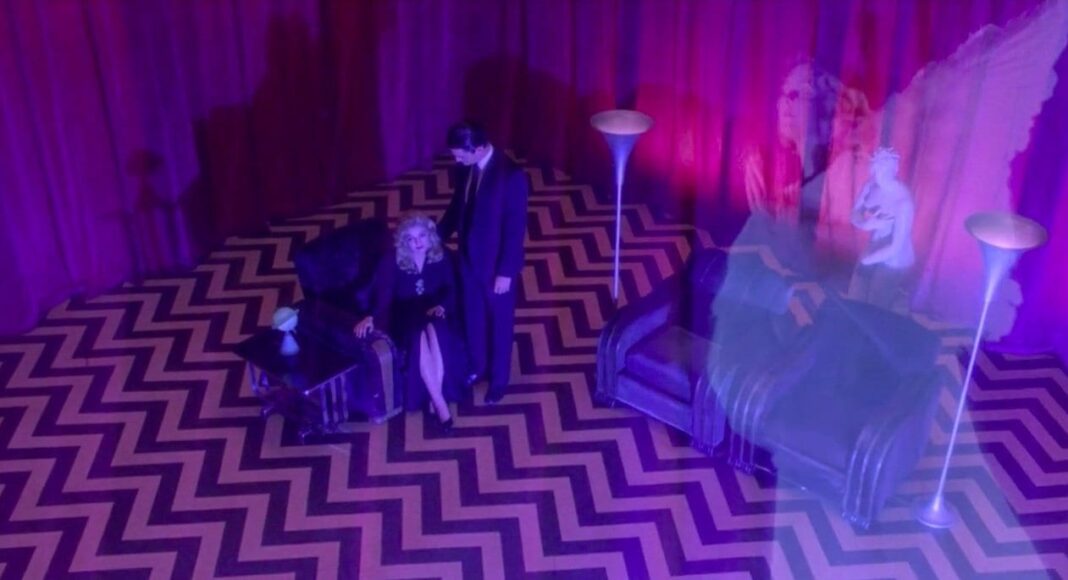Through the darkness of future’s past, The magician longs to see. One chants out between two worlds…
Released in August 1992, Fire Walk with Me, the prequel-sequel to the prematurely-canceled ABC hit, Twin Peaks (1990-1991), mostly takes place during the week build up to, and the early morning of homecoming queen Laura Palmer’s murder – February 24, 1989.
Remember the saga intimately-connected to the current week by revisiting the criminally misunderstood “masterpiece,” by We Own the Night and Lost City of Z director James Gray’s calculations.
The since-reclaimed visceral two-plus hour documentation of the underworld lurking beneath a northwest smalltown fills in the blanks set up by its predecessor. Exactly how could a promiscuous and in-peril teen come to earn the waystation ring-and-halo combo that would christen her David Lynch’s in-world protector against evil manifested?
An ample answer is not somewhere over the rainbow, or even beneath the Sycamore trees; it’s between a rock and a “lodge” place.
Twin Peaks mostly covered the FBI-involved investigation into Laura’s complicated demise; Lynch’s relentless, anti-TV follow-up adaptation of his own abandoned Marilyn Monroe biopic-rooted allegory kicks off with a long-form prologue devoted to the establishment of the serial killer pattern Special Agent Dale Cooper (Kyle MacLachlan) correctly foresaw reappearing.
By the time we trek back into the town of Twin Peaks at the first act break, we’re more than prepared to fully experience the good, the bad, and the deeply twisted it has to offer; and without network interference this go-around.
Executives infamously forced Lynch to reveal the identity of Laura’s killer – a civilian possessed by the demon known as “Bob,” to then complete his nuclearly savage, innocence-targeting bidding – much earlier than he preferred.
Lynch’s window back into the world a year after it closed its loop represents a clear wink of sorts from the director to his audience. The opening credits roll in over busy television noise before we pull back and witness the TV’s destruction.
Stream the movie – currently available on HBO Max – and get ready for unadulterated Lynch. Think Blue Velvet without a transcendentally meditative calm-down. Sheryl Lee delivers a beyond scream queen – dare I say, Hitchockian leading lady? – performance, no longer limited to archive flashbacks or playing her own identical cousin.
What renders contemporary viewers compelled by Laura’s shamelessly authentic survivor’s pathos, utterly befuddled them back then. In fact, the film debuted to roaring boos at the 1992 Cannes Film Festival, with one notable Lynch-loving up-and-comer unsettled enough to renounce the filmmaker altogether.
“David Lynch had disappeared so far up his own a** that I have no desire to see another David Lynch movie until I hear something different. And you know, I loved him. I loved him,” Quentin Tarantino said in a 1992 interview.
Yet, it’s undeniable the beacon of hope Laura ultimately symbolizes bears a two sides of the same coin resemblance to Tarantino’s characterization of Sharon Tate in the Manson Family-as-a-backdrop Once Upon a Time in Hollywood (2019).
The 1992 film continuation to his franchise-generating melodrama is Lynch’s admission to the masses: this is closer to my vision than anything they’d ever let me do on TV (until 2017, when Showtime agreed the gum everyone liked, was actually beloved). Despite co-creating the 30-episode original with Mark Frost, Lynch only directed six episodes – each of which you can pick out of a lineup based on the heightened dreamscape energy and lack of “lumberjack Coop.”
It’s the perfect preamble to the breathtaking season 3, as well. Twin Peaks: The Return is an 18-part movie filmed from one script – then episodically broken up on-screen by rousing Roadhouse sets put on by everyone from The Chromatics to The Nine Inch Nails.
If you watched the original two-season batch of mysteries, and think you have the gist heading into the revival without having seen the film, think again. You haven’t remotely seen anything worth a David Lynchian damn until you’ve experienced…
Fire! Walk with me.





